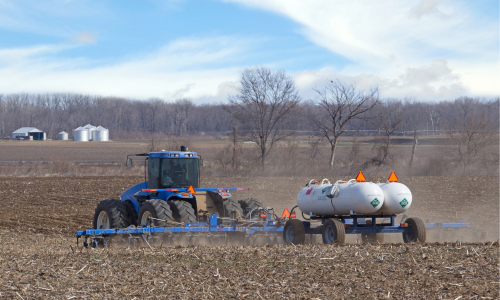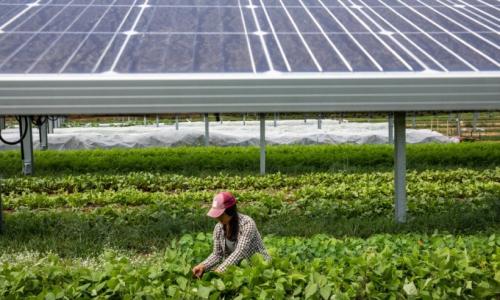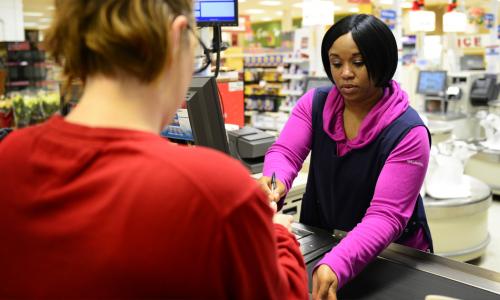Shopping for Change
Under the slick supermarket packaging lies a food system that’s failing us. The good news is, we know how to build a better one.
Learn more
People get their food from lots of places—restaurants, farmstands, corner stores, sometimes even a backyard garden or kitchen windowsill. But for most US consumers, no food source is more familiar than the supermarket—that 20th-century invention where aisle after aisle bursts with colorful boxes, bags, jars and cans of conveniently packaged food products.
Usually we go to the supermarket with a simple agenda: to get what we need to put dinner on the table, at a price we can afford. But today we’re going on a different kind of shopping trip. Each time we pull an item off the shelf, we’ll learn about some of the ways the US food system is falling short of meeting our needs—and how we can turn it into a food system that works for all of us.
The Illusion of Choice
On the surface, a supermarket offers a breathtaking abundance of food options. But much of what lines those shelves is not good for our bodies, our communities, or our environment. If we want healthy, affordable food that’s produced fairly and sustainably, our choices are sadly limited.
This situation didn’t arise in a vacuum—it's the result of deliberate decisions by business leaders to maximize profits at the expense of farmers, workers, and eaters. Instead of promoting public health and thriving, sustainable farms and communities, our food system is making us sick, fouling our environment, exploiting workers, and forcing farmers out of business—with communities of color facing the worst of all these impacts. And federal food policy, heavily influenced by industry lobbying, helps maintain this destructive status quo.
It doesn’t have to be that way. Together, we can change the food system to one that provides healthy food for all, regenerates resources, promotes racial equity, and treats workers fairly at every stage in the system. In fact, this transformation is already underway—we just need to help it grow.
But all this talk about food is making us hungry.
{{ modal.label }}
What’s In Your Shopping Cart—and What It Means
We went to the supermarket for some basic food items, and came out with more than we bargained for.
The problems we encountered on our food shopping trip have one thing in common: they're all symptoms of a system designed to prioritize corporate bottom lines over human needs.
The good news is that precisely because food system problems are closely connected, so are the solutions. The transformative policies and practices we advocate at UCS can be win-wins for workers, farmers, consumers, and our shared environment.
Of course, we’ve barely scratched the surface of all that could be said about both the problems and the promise of the US food system. We encourage you to learn more, and to join us in making change. (And then, have something good to eat!)
Are you ready to make an impact?
Learn more about what you can do to create a more healthy and sustainable future.
Your receipt
Your cart is empty. View some items and learn more about the food system issues behind the supermarket shelves.
Select a section to begin adding items to your cart.
Each item will reveal a food system challenge or opportunity, along with ways to make positive change and resources for further learning.
Your cart is empty. Ready?
Designed by LimeRed Studio
- Fruit
- Panel 1: Marco Verch/CC BY 2.0
- Panel 2: National Institutes for Occupational Safety and Health
- Panel 3: Erik Scheel
- Panel 4: Lance Cheung/USDA
- Coffee
- Panel 1: Theo Crazzolara/CC BY 2.0
- Panel 2: World Agroforestry Centre/CC BY-NC-SA 2.0
- Panel 3: Kris Fricke/CC BY-NC-SA 2.0
- Panel 4: Your Best Digs/CC BY 2.0
- Meat
- Panel 1: Lance Cheung/USDA
- Panel 2: Darcy Maulsby/iStock
- Panel 3: Lance Cheung/USDA
- Panel 4: Montserrat Solis/Pexels
- Cereal
- Panel 1: mroach/CC BY-SA 2.0
- Panel 2: vencavolrab/iStock
- Panel 3: Ella Olsson/CC BY 2.0
- Panel 4: Ocean Photography/veer
- Vegetables
- Panel 1: bmeabroad/CC BY-NC-SA 2.0
- Panel 2: Preston Keres/USDA
- Panel 3: Amelia Moore/UCS
- Panel 4: Lance Cheung/USDA
- Soda
- Panel 1: marlith/CC BY-SA 3.0
- Panel 2: Chelsea Browning/US Air Force
- Panel 3: Arlington Department of Environmental Services
- Panel 4: OcusFocus/iStock
- Eggs
- Panel 1: Marco Verch/CC BY 2.0
- Panel 2: ITamar K.
- Panel 3: Ryan Thompson/CC BY-NC-SA 2.0
- Panel 4: Lance Cheung/USDA
- Seafood
- Panel 1: Justin Marx/CC BY-NC-SA 2.0
- Panel 2: NOAA's National Ocean Service
- Panel 3: Monterey Bay Aquarium
- Panel 4: llee_wu/CC BY-ND 2.0
- Legumes
- Panel 1: Justinc/CC BY-SA 2.0
- Panel 2: Jo Zimny/CC BY-NC-ND 2.0
- Panel 3: David Oien
- Panel 4: Michael Hilton/CC BY 2.0
- The Dumpster
- Panel 1: USDA/CC BY 2.0
- Panel 2: Amber Karnes/CC BY-NC-ND 2.0
- Panel 3: Produce Marketing Association/CC BY-NC-ND 2.0
- Panel 4: Deborah Kane/USDA/CC BY 2.0
- The Back Office
- Panel 1: sirmichael/CC BY-NC-ND 2.0
- Panel 2: Fibonacci Blue/CC BY 2.0
- Panel 3: Lori Eanes
- Panel 4: Lance Cheung/USDA
- The Cash Register
- Panel 1: pxhere
- Panel 2: USDA/CC BY 2.0 (Flickr)
- Panel 3: US Air Force
- Panel 4: Lance Cheung/USDA



